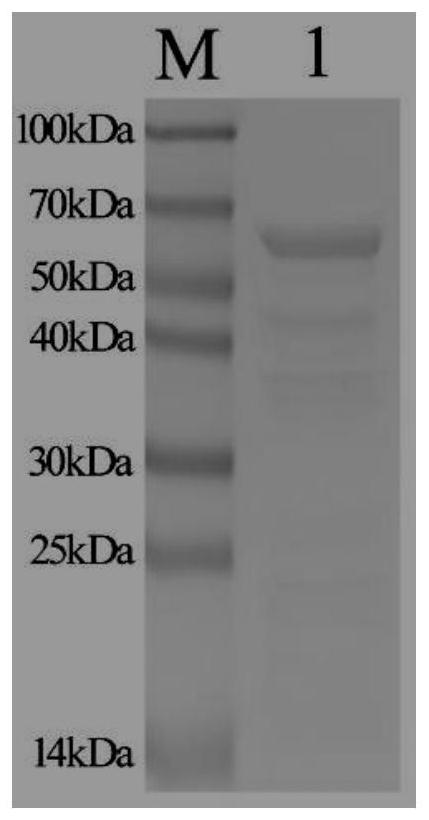Colloidal gold test strip for detecting sheep fasciola hepatica infection circulating antigen
A technology of colloidal gold test paper and Fasciola goat liver fluke, which is applied in the field of immunology, can solve problems such as lack, and achieve the effects of easy portability, rapid detection, and guaranteed specificity
- Summary
- Abstract
- Description
- Claims
- Application Information
AI Technical Summary
Problems solved by technology
Method used
Image
Examples
Embodiment 1
[0032] Example 1 Expression and Purification of Fasciola hepatica Cathepsin L Recombinant Protein
[0033] 1. Inoculate the BL21 positive strain of Fasciola hepatica cathepsin L recombinant protein into LB medium, and activate it by culturing at a constant temperature of 37°C. The activated strain was re-inserted into LB medium, and cultured at a constant temperature of 37°C until the OD of the bacterial solution 600 The value is 0.6, adding inducer, and inducing at 37°C for 8 h. The supernatant was discarded by centrifugation. The pellet was resuspended in PBS and sonicated. The bacterial solution was centrifuged to take the precipitated sample and subjected to SDS-PAGE electrophoresis, and the gel was stained with Coomassie brilliant blue staining solution.
[0034] 2. Introduce the positive strains into a large amount of LB medium in proportion, prepare a large number of protein samples according to the previous step and perform conventional SDS-PAGE electrophoresis, soa...
Embodiment 2
[0038] Preparation and purification of monoclonal antibody against Fasciola hepatica cathepsin L
[0039] 1. Immunize BALB / C mice with purified Fasciola hepatica cathepsin L recombinant protein, immunize 4 times, and detect the antibody titer in the serum after each interval of 1 week, select the mouse with the highest titer before the cell fusion test 3-day booster immunization;
[0040] 2. Blow off the adherent SP2 / 0 cells and transfer to a centrifuge tube. Blood was collected from the eyes of the mouse, killed by neck dislocation, the spleen was removed, crushed, sieved and purified by centrifugation; the thymus was removed and processed in the same way; the processed thymocytes were transferred to a centrifuge tube, added with HAT and HT and placed at a constant temperature of 37°C spare in the box;
[0041] 3. Discard the supernatant of the centrifuged splenocytes, add IMDM to mix, and centrifuge to discard the supernatant. Place the centrifuge tube in a 37°C water bat...
Embodiment 3
[0060] Preparation and purification of polyclonal antibody against Fasciola hepatica cathepsin L
[0061] 1. Use the purified Fasciola hepatica cathepsin L recombinant protein to immunize New Zealand rabbits for 3 times. After the third immunization, the antibody titer in the serum was detected at an interval of 7 days, blood was collected from the heart, and the serum was separated.
[0062] 2. Mix the serum and Tris-HCl buffer evenly, and centrifuge to absorb the supernatant. Equilibrate the purification column with sodium phosphate solution, inject the serum into the purification column, wash thoroughly and elute the antibody with the eluent and collect it into a centrifuge tube. The eluate was put into a dialysis bag and submerged in PBS solution for dialysis at 4°C overnight, and a small amount of sample was taken for SDS-PAGE electrophoresis staining analysis.
[0063] result
[0064] 1. Determination of titer of rabbit polyclonal antibody against Fasciola hepatica ca...
PUM
 Login to View More
Login to View More Abstract
Description
Claims
Application Information
 Login to View More
Login to View More - R&D Engineer
- R&D Manager
- IP Professional
- Industry Leading Data Capabilities
- Powerful AI technology
- Patent DNA Extraction
Browse by: Latest US Patents, China's latest patents, Technical Efficacy Thesaurus, Application Domain, Technology Topic, Popular Technical Reports.
© 2024 PatSnap. All rights reserved.Legal|Privacy policy|Modern Slavery Act Transparency Statement|Sitemap|About US| Contact US: help@patsnap.com










